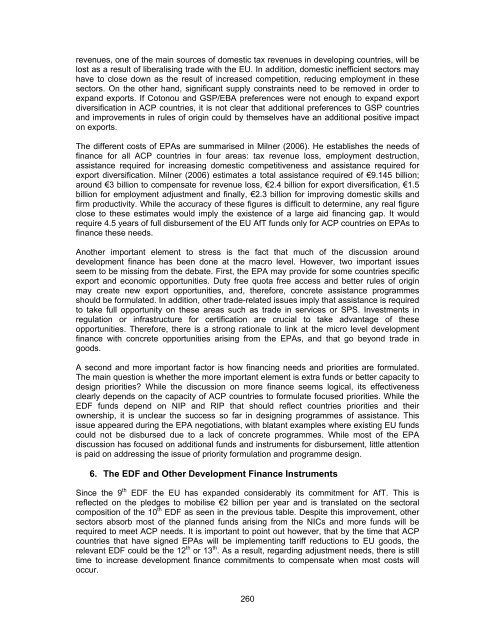EPA Review Annex Documents - DFID
EPA Review Annex Documents - DFID
EPA Review Annex Documents - DFID
Create successful ePaper yourself
Turn your PDF publications into a flip-book with our unique Google optimized e-Paper software.
evenues, one of the main sources of domestic tax revenues in developing countries, will be<br />
lost as a result of liberalising trade with the EU. In addition, domestic inefficient sectors may<br />
have to close down as the result of increased competition, reducing employment in these<br />
sectors. On the other hand, significant supply constraints need to be removed in order to<br />
expand exports. If Cotonou and GSP/EBA preferences were not enough to expand export<br />
diversification in ACP countries, it is not clear that additional preferences to GSP countries<br />
and improvements in rules of origin could by themselves have an additional positive impact<br />
on exports.<br />
The different costs of <strong>EPA</strong>s are summarised in Milner (2006). He establishes the needs of<br />
finance for all ACP countries in four areas: tax revenue loss, employment destruction,<br />
assistance required for increasing domestic competitiveness and assistance required for<br />
export diversification. Milner (2006) estimates a total assistance required of €9.145 billion;<br />
around €3 billion to compensate for revenue loss, €2.4 billion for export diversification, €1.5<br />
billion for employment adjustment and finally, €2.3 billion for improving domestic skills and<br />
firm productivity. While the accuracy of these figures is difficult to determine, any real figure<br />
close to these estimates would imply the existence of a large aid financing gap. It would<br />
require 4.5 years of full disbursement of the EU AfT funds only for ACP countries on <strong>EPA</strong>s to<br />
finance these needs.<br />
Another important element to stress is the fact that much of the discussion around<br />
development finance has been done at the macro level. However, two important issues<br />
seem to be missing from the debate. First, the <strong>EPA</strong> may provide for some countries specific<br />
export and economic opportunities. Duty free quota free access and better rules of origin<br />
may create new export opportunities, and, therefore, concrete assistance programmes<br />
should be formulated. In addition, other trade-related issues imply that assistance is required<br />
to take full opportunity on these areas such as trade in services or SPS. Investments in<br />
regulation or infrastructure for certification are crucial to take advantage of these<br />
opportunities. Therefore, there is a strong rationale to link at the micro level development<br />
finance with concrete opportunities arising from the <strong>EPA</strong>s, and that go beyond trade in<br />
goods.<br />
A second and more important factor is how financing needs and priorities are formulated.<br />
The main question is whether the more important element is extra funds or better capacity to<br />
design priorities? While the discussion on more finance seems logical, its effectiveness<br />
clearly depends on the capacity of ACP countries to formulate focused priorities. While the<br />
EDF funds depend on NIP and RIP that should reflect countries priorities and their<br />
ownership, it is unclear the success so far in designing programmes of assistance. This<br />
issue appeared during the <strong>EPA</strong> negotiations, with blatant examples where existing EU funds<br />
could not be disbursed due to a lack of concrete programmes. While most of the <strong>EPA</strong><br />
discussion has focused on additional funds and instruments for disbursement, little attention<br />
is paid on addressing the issue of priority formulation and programme design.<br />
6. The EDF and Other Development Finance Instruments<br />
Since the 9 th EDF the EU has expanded considerably its commitment for AfT. This is<br />
reflected on the pledges to mobilise €2 billion per year and is translated on the sectoral<br />
composition of the 10 th EDF as seen in the previous table. Despite this improvement, other<br />
sectors absorb most of the planned funds arising from the NICs and more funds will be<br />
required to meet ACP needs. It is important to point out however, that by the time that ACP<br />
countries that have signed <strong>EPA</strong>s will be implementing tariff reductions to EU goods, the<br />
relevant EDF could be the 12 th or 13 th . As a result, regarding adjustment needs, there is still<br />
time to increase development finance commitments to compensate when most costs will<br />
occur.<br />
260
















